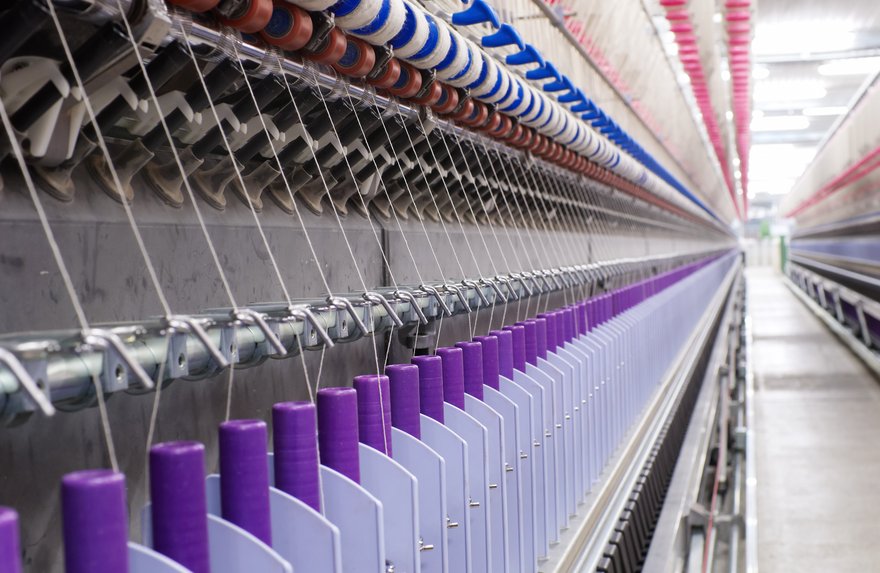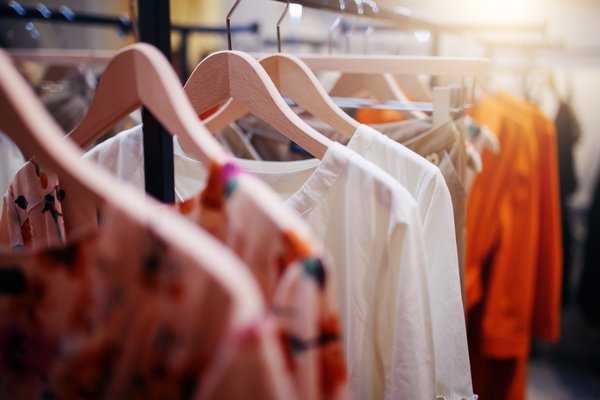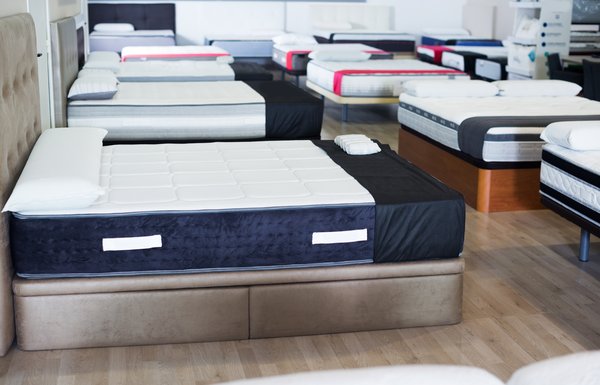The global textiles market has experienced significant shifts over the last several years, brought about by rapid changes in consumer spending appetites, inflation, and changes in the global supply chain. In the first half of 2024, U.S. imports of textiles and apparel declined 3.6% to $49.4 billion from $51.2 billion during the same period of 2023.
Estimates show that the global apparel market generated an estimated $1.79 trillion in 2024, with the U.S. accounting for 20% of the total market share. Between 2024 and 2030, fashion e-commerce spending is on track to rise at a compound annual growth rate of almost 9% in the U.S. alone. Meanwhile, the global textile market was valued at just shy of $2 trillion in 2024 and is expected to be worth more than $3 trillion by 2030.
Apparel demand and the astronomical growth in the global e-commerce market, despite shifts in consumer spending behaviors, continue to be major growth drivers for the textile industry. If you are a long-term investor who wants to capitalize on these trends and learn how to invest in textile stocks, keep reading.

Top textile stocks
Investing in textile stocks in 2025
Many textile companies specialize in processing raw materials for clothing and accessories. Some of the best textile companies develop new textiles and clothing and use their know-how to forge direct relationships with customers. The direct-to-consumer (DTC) sales trend has benefited textile companies by enabling top textile manufacturers to become retailers themselves -- a clear competitive advantage over relying on someone else for sales distribution.
Here are a few textile stocks to consider:
1 - 3
1. Lululemon Athletica
Athleisure -- athletic-inspired apparel for everyday wear -- was popularized by Canadian company Lululemon Athletica (LULU 0.86%) and has become culturally cemented in place in recent years. More than just stretchy pants and comfortable workout clothes, athleisure has become part of high fashion. Athleisure pioneer Lululemon has generated plenty of revenue by advancing this segment of the textile market.
Approximately 40% of Lululemon's revenue comes from DTC online sales, even as in-person shopping is increasing. The company has cultivated a loyal customer base through its website, social media, and other digital channels. The company originally specialized in women's clothing, but it has since added full clothing lines for men and children.
It's also highly profitable and has a strong track record of generating plenty of free cash flow. Lululemon's business model is asset-light, meaning that it does not directly own any manufacturing operations.
By having partners actually make the clothes, Lululemon can focus on managing the supply chain and owning the customer relationship. This is the far more valuable portion of the business.
2. Canada Goose
Also based north of the border, Canada Goose (GOOS 0.22%) is a top textile company and retailer. Canada Goose prides itself on making the down-filled parkas it is known for at its own manufacturing operations in Toronto. The company also makes knitwear and accessories that are produced in other locations in Europe and Asia.
Originally famous for making adventure and extreme weather gear, Canada Goose has grown into a global luxury brand that manufactures a variety of adventure-inspired apparel. The company has experienced success online via DTC sales despite fluctuating revenue growth and profitability. Approximately 40% of its sales come from the web.
In Canada Goose's 2024 fiscal year, which ended on March 31, 2024, total revenue increased 10% to $1.3 billion compared to the prior year period. In the 12-month period, DTC revenue grew 18% to $950.7 million, even as wholesale revenue decreased 16%. While down from the prior fiscal year, the company also reported a net income of $58 million in its fiscal 2024.
Management regularly announces share repurchases to return excess cash to shareholders. The company is expanding quickly in international markets, as well. For the socially conscious investor, it's worth noting that Canada Goose ended all animal fur purchasing by the end of 2022.
3. Levi Strauss
Levi Strauss (LEVI 0.89%) is an iconic American brand trying to find its way in a new era. Although the denim company traces its roots to the California Gold Rush more than 150 years ago, it only became a public company in 2019. Levi Strauss and its global jeans manufacturing empire have adapted by closing brick-and-mortar locations and refocusing on online sales.
About 44% of its revenue is now derived from digital channels, which include its own e-commerce business and online sales operations by its partners. In the first nine months of 2024, Levi Strauss reported net revenue of $4.5 billion, flat compared to the year-ago period. While net income plunged 77% year-over-year to $28 million, adjusted net income rose 15% to $301 million.
Levi Strauss stock also pays a small quarterly dividend to sweeten the deal, which currently yields about 3%.
4 - 6
4. Kontoor Brands
Kontoor Brands (KTB -1.2%) is another top denim maker in the textile industry. Kontoor's parent company until 2019 was VF Corporation (VFC -0.51%), owner of brands including Vans, The North Face, and Timberland. Now, as an independent company, it owns the denim brands Lee, Wrangler, and Rock & Republic.
A focus on e-commerce has presented helpful growth tailwinds for Kontoor, with Lee and Wrangler finding new success with DTC marketing. Kontoor's business is also expanding overseas, and the company remains highly profitable.
In the third quarter of the company's fiscal 2024, revenue was $670 million and increased 2% compared to the prior year, driven by growth in both global direct-to-consumer and U.S. wholesale revenues.
Although down 2% from the comparable period in 2023, Kontoor's revenue in the first nine months of 2024 was just shy of $2 billion. However, net income for the nine-month period rose 12% year-over-year to approximately $182 million.
As an added bonus, Kontoor pays a dividend to shareholders and has initiated a share repurchase program. Its dividend currently yields in the ballpark of 2.5%.
5. HanesBrands
HanesBrands (HBI 2.0%) is the parent company of brands such as Hanes and Champion. It has struggled to adapt to the digital era, and the last several years have brought about difficulties for the business, including debt issues, mixed profitability, and fluctuating revenue.
The company's share price has also fluctuated significantly over the last few years, but is up more than 100% over the trailing 12-month period at the time of this article.
HanesBrands has been working to aggressively develop its athletic wear business and e-commerce sales in recent years. It has also been working to optimize and consolidate its supply chain to reduce overhead costs.
In February 2023, HanesBrands eliminated its dividend to focus on reducing debt. The company had previously paid a $0.60 annual dividend for almost a decade.
In the first nine months of 2024, HanesBrands reported net sales of $2.7 billion, down 6% from the same period in 2023. The company also reported a net loss of about $308 million. However, the company did generate profits on the bottom line of about $30 million in the third quarter of 2024.
It also ended the period with liquidity of more than $1.4 billion, consisting of $317 million of cash and equivalents and approximately $1.1 billion of available capacity under the company’s credit facilities.
6. Tapestry
Not all textiles are fabric. Famous for its leather goods, Tapestry (TPR -0.55%) is another top name in the textile industry. The conglomerate manages high-end accessories and apparel brands, including Coach, Kate Spade, and Stuart Weitzman.
At the time of this article, the trailing 12 months have seen the stock's price climb by close to 90%. Tapestry also pays a dividend that yields around 2%.
The luxury and high-end apparel industry had historically been reluctant to pursue online sales. Tapestry seized on that reluctance as a business opportunity, becoming one of the pioneer luxury online retailers.
Although growth has been slow in recent years, its profitability remains strong and its family of brands are household names for luxury-minded consumers. The company hopes to win over a younger, digitally focused generation of high-end shoppers.
In the first quarter of the company's fiscal 2025, net sales totaled $1.51 billion, roughly in-line with the prior year. Net income totaled $187 million and operating income came to $252 million for the three-month period.
Related investing topics
Are they right for you?
Are textile stocks right for you?
Like much of the rest of the economy, the textile industry is undergoing structural changes accelerated by numerous disruptive forces in the 2020s. Comfortable attire inspired by athletic wear is here to stay, and consumers are showing no signs of losing interest in shopping from home.
As the global economy moves forward and consumer spending realigns, shopping for new ensembles is making a comeback. All of this creates opportunities for the textile companies that are also e-commerce companies.
Companies that are making use of the advances of the digital era are entering a new period of growth. Investors who are comfortable with the risks of growth investing can consider including any of these top textile stocks as part of a diversified portfolio.
























